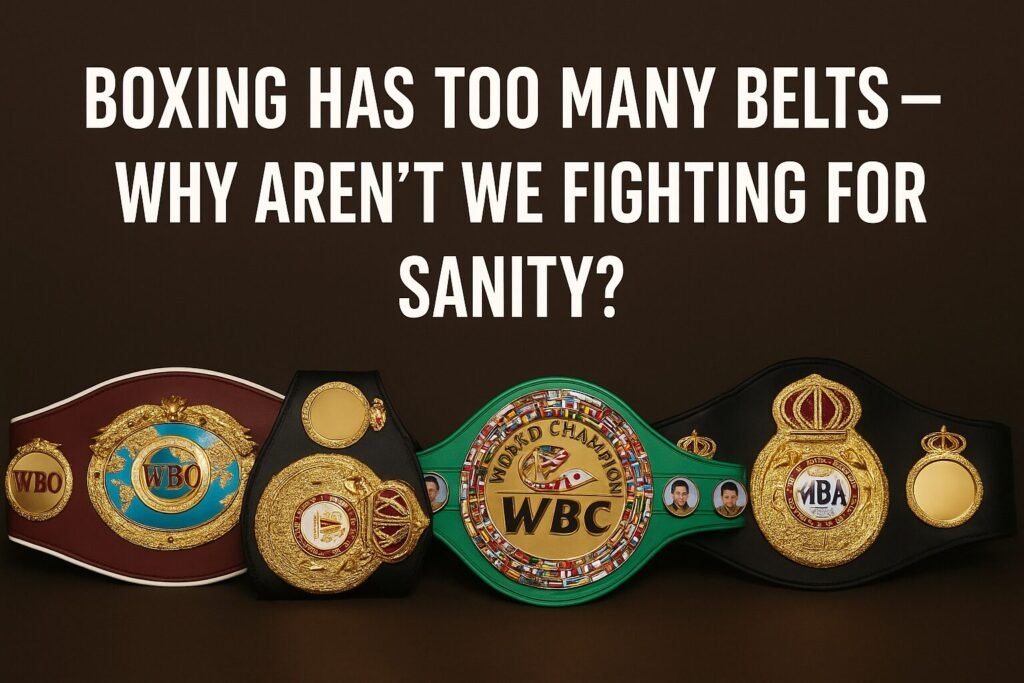It’s official: boxing has a belt problem. And no, I’m not talking about someone’s shorts falling down mid-round — I mean the mess of so-called “world titles” floating around like confetti at a poorly planned wedding.
Once upon a time, being called ‘world champion’ meant you were the man. Now? It just means you’ve got a good lawyer, a willing promoter, and the money to pay sanctioning fees. We’re living in an era of boxing belt overload, and it’s killing the sport’s clarity.
60 World Titles and Counting — Who’s Actually in Charge?
Let’s break it down. We’ve got the WBC, WBA, IBF and WBO — the “Big Four” — all handing out world titles in every division. That’s four champions per weight class before you even get into “regular”, “super”, “interim”, “silver”, “gold”, “franchise”, “global” and god knows what else.
Take the heavyweight division. In theory, it’s the glamour weight class. But even here, half the fans couldn’t tell you who holds what without checking BoxRec first. It’s a joke.
And I’ve spoken about this before in my post One World, One Champion — but since then, if anything, it’s only got worse. Titles are multiplying like gremlins after midnight.
Sanctioning Fees: The Real Champion of Modern Boxing
Here’s the uncomfortable truth — belts = money. Every time a “world title” is contested, the sanctioning body takes a cut. That’s why there’s a new strap being cooked up every time someone fancies headlining a show.
Promoters love it because they can slap “world title” on a poster. Fighters love it because they can put “world champion” in their Instagram bio. And fans? We get stuck trying to untangle the alphabet soup of boxing’s so-called elite.
Do Fans Actually Want This Many Belts?
This is where it gets tricky. Some argue that more belts mean more opportunity. More chances for fighters to get paid, gain recognition, and headline shows. But if everyone’s a champion, then nobody is. It devalues the whole concept.
Look at MMA. The UFC has one champion per weight class, and fans know exactly who the top dog is. In boxing? We need flowcharts.
Truth is, the demand for belt clutter isn’t coming from fans — it’s being fed to us by promoters and networks. It’s easier to sell a main event when there’s a shiny trinket on the line, even if it means nothing.
Could One-Belt Per Division Actually Work?
In theory, absolutely. Have one global governing body, one champion per division, with interim belts only for genuine injury layoffs or mandated delays. Simple, clean, and gives boxing the structure it desperately needs.
But in practice? Not a chance. Not in this current climate, where boxing is stitched together by conflicting interests, business deals, and backroom politics.
If you did set up one unified body, you’d still run into the same problem: who enforces the mandatories? If it’s left to promoters, we’ll still never see the best fight the best. And if it’s centrally mandated, you’d better believe the infighting and ducking will just find new forms.
More than anything, boxing’s bloat problem is a power problem.
The Worst Part? We’re Losing the Plot
We spend more time arguing over belts, rankings, and sanctioning bodies than we do talking about the actual fights. You know, the reason we all fell in love with this sport to begin with?
There are still elite talents out there — but most casual fans have no idea who the real champion is in any given division. The hierarchy’s gone, the credibility’s gone, and unless something changes, the sport risks losing its grip on the next generation.
Are you sick of the boxing belt overload too? Do you even care who holds what anymore — or are you more interested in who’s actually the best?
Let me know in the comments below. And if you want more straight-talking boxing opinion, visit CMBoxing and share this post with a mate who’s just as lost in the belt soup as the rest of us.
Let’s keep the conversation — and the sport — alive.

